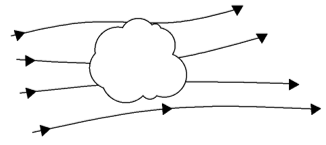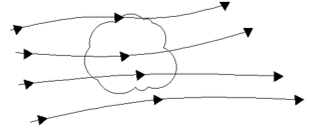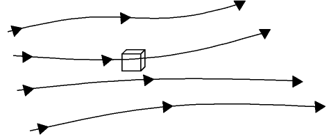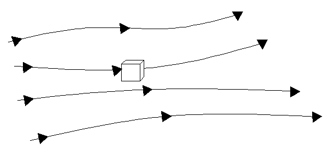This set of Computational Fluid Dynamics Multiple Choice Questions & Answers (MCQs) focuses on “Continuity Equation – Finite Control Volume”.
1. The physical principle behind the continuity equation is __________
a) Mass conservation
b) Zeroth law of thermodynamics
c) First law of thermodynamics
d) Energy conservation
View Answer
Explanation: Continuity equation is derived from the mass conservation principle. It states that for an isolated system, the mass of the system must remain constant.
2. Which of these models directly gives this equation?
\(\frac{∂}{∂t}\iiint_v\rho dV+\iint_s \rho\vec{V}.\vec{dS}=0 \)
a)

b)

c)

d)

View Answer
Explanation: The equation is in conservative integral form. So, the model must be finite control volume fixed in space.
3. Which of these models directly gives this equation?
\(\frac{D}{Dt}\iiint_v\rho dV = 0\)
a)

b)

c)

d)

View Answer
Explanation: The equation is the non-conservative form of the integral continuity equation. This is obtained from a finite control volume moving along with the flow.
4. Consider a model of finite control volume (volume V and surface area S) fixed in space with elemental volume dV, vector elemental surface area d\(\vec{S}\), density ρ and flow velocity \(\vec{V}\). What is the net mass flow rate out of the surface area?
a) \(\iint_V\rho \vec{V}.dV\)
b) \(\rho \vec{V}.d \vec{S}\)
c) \(\iiint_V\rho \vec{V}.d\vec{S}\)
d) \(\iint_V\rho \vec{V}.d\vec{S}\)
View Answer
Explanation: In general,
mass flow rate=density × velocity × area
For this case,
elemental mass flow rate = \(\rho \vec{V}.d \vec{S}\)
total mass flow rate=\(\iint_V\rho \vec{V}.d\vec{S}\)
5. Consider a model of finite control volume (volume V and surface area) fixed in space with elemental volume dV, vector elemental surface area d\(\vec{S}\), density ρ and flow velocity \(\vec{V}\). What is the mass inside the control volume?
a) \(\iint_s\rho \vec{V}.d\vec{S}\)
b) \(\iiint_V\rho dV\)
c) ρdV
d) \(\frac{\partial}{\partial t} \iiint_V\rho dV\)
View Answer
Explanation: Mass=density × volume
mass inside dV=ρdV
mass inside \( V=\iiint_V\rho dV\).
6. Consider a model of finite control volume (volume V and surface area) moving along the flow with elemental volume dV, vector elemental surface area d\(\vec{S}\), density ρ and flow velocity \(\vec{V}\). What is the time rate of change of mass inside the control volume?
a) \(\iiint_V\rho dV\)
b) \(\frac{\partial}{\partial t} \iiint_V\rho dV\)
c) \(\frac{D}{Dt} \iiint_V\rho dV\)
d) ρdV
View Answer
Explanation: Substantial derivative is used as the model is moving.
mass=density × volume
mass inside dV=ρdV
mass inside \( V=\iiint_V\rho dV\)
time rate of change of mass inside \(\frac{D}{Dt} \iiint_V\rho dV\).
7. To convert the non-conservative integral equation of mass conservation into the conservative integral form, which of these theorems is used?
a) Stokes theorem
b) Kelvin-Stokes theorem
c) Gauss-Siedel theorem
d) Gauss Divergence Theorem
View Answer
Explanation: The expansion of non-conservative integral equation gives two volume integral terms. One of these terms representing the mass flow is converted into surface integral using the Gauss Divergence theorem.
8. Consider a model of finite control volume (volume V and surface area) fixed in space with elemental volume dV, vector elemental surface area d\(\vec{S}\), density ρ and flow velocity \(\vec{V}\).
\(\rho\vec{V}.d\vec{S}\) is positive when _____________
a) The mass flow is outward
b) The mass flow is inward
c) The mass flow is positive
d) The mass flow is negative
View Answer
Explanation: d\(\vec{S}\) always points outwards to the control volume. So, the product \(\rho\vec{V}.d\vec{S}\) is positive when the mass flow is outwards.
9. What is the physical statement of mass conservation equation for a finite control volume fixed in space?
a) Net mass flow through the control surface = constant
b) Rate of change of mass inside the control volume = constant
c) Net mass flow through the control surface = Rate of change of mass inside the control volume
d) Net mass flow through the control surface≠Rate of change of mass inside the control volume
View Answer
Explanation: Statement of mass conservation equation for a finite control volume fixed in space:
Net mass flow through the control surface is equal to the rate of change of mass inside the control volume.
10. What is the physical statement of mass conservation equation for a finite control volume moving along with the flow?
a) Rate of change of mass inside the control volume = 0
b) Rate of change of mass inside the control volume = constant
c) Net mass flow through the control surface = Rate of change of mass inside the control volume
d) Net mass flow through the control surface≠Rate of change of mass inside the control volume
View Answer
Explanation: Statement of mass conservation equation for a finite control volume moving along with the flow:
Mass inside the control volume = constant
Rate of change of mass inside the control volume = 0.
Sanfoundry Global Education & Learning Series – Computational Fluid Dynamics.
To practice all areas of Computational Fluid Dynamics, here is complete set of 1000+ Multiple Choice Questions and Answers.
If you find a mistake in question / option / answer, kindly take a screenshot and email to [email protected]
- Apply for Chemical Engineering Internship
- Apply for Mechanical Engineering Internship
- Practice Chemical Engineering MCQs
- Practice Mechanical Engineering MCQs
- Check Mechanical Engineering Books
